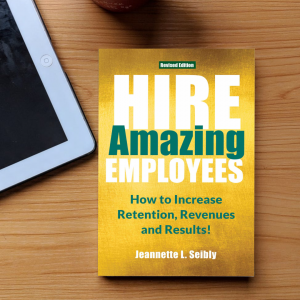
As hiring managers, recruiters, and interviewers, too often we listen through our biases and judgments to determine whether a person can do the job or not.
- We’re listening to respond, which is not true listening.
- Or, we’re just not really listening for anything and just waiting to ask the next question.
- Or, we’re contemplating if we’ve already made the right decision about hiring the person (not based on objective data).
- Hint: If you have a response before the person finishes speaking, you’re not listening!
Skills you may already be listening for:
- Attention to detail: Do they dot the I’s and cross the T’s?
- Ability to stay calm under pressure: Do they react impulsively or remain steady when challenged?
- Be a team player: Do they work well with others, or are they know-it-alls or do-it-yourselfers?
- Coachability: Ability and willingness to accept feedback and learn from their mistakes and failures.
- Communication: How well are they listening to you?
How Using Job-Fit Assessments Clarifies What to “Listen For”
Using a qualified and objective job-fit assessment (e.g., PXT Select®) provides “Listen for …” cues in the Selection Reports. These reports outline how a candidate’s thinking style, behavioral traits, and occupational interests align with the role. When you combine these insights with the interview questions in the PXT Select® report, you gain objective evidence of whether the person can do the job, will do the job, and can do the job here.
This clarity helps you know where to probe further, using the Rule of 3 from Hire Amazing Employees, and keeps you emotionally detached from the candidate’s charm or a false impression that can cloud judgment.
Additional Behaviors Worth “Listening For”
- Consistency between words and actions: Do their examples align with how they describe themselves? Use the Rule of 3 (Hire Amazing Employees) to deep dive into someone’s true ability — not just to complete the skill or task, but to think through the pros and cons of what they are doing.
- Ownership of mistakes: Candidates who can admit missteps and explain what they learned often bring resilience to the job. Interviewer question: “Tell me about the last mistake you made and what you did to fix it. Who did you talk with?”
- Curiosity and initiative: Listen for questions they ask about the role, team, or company. Genuine curiosity signals engagement. If they have no questions or it’s clear they didn’t do any prep work on the company, position, or interviewer, you may need to move on.
- Values alignment: Beyond skills, listen for whether their personal values resonate with the culture you’re building. What common themes do they describe, perhaps without realizing it? For example, if they struggled in the past with a micromanaging boss, how did they handle it? What type of autonomy do they need in this job to be successful?
- Communication clarity: Are they able to simplify complex ideas, or do they get lost in jargon? Can they explain what they are saying in words others would easily understand?
Practical “Listening For” Habits for You
- Pause before responding. Give space for silence. It often reveals more than a rushed answer.
- Notice patterns, not isolated statements. One polished story doesn’t equal consistency.
- Note emotional tone. Calm confidence differs from rehearsed charm.
- Separate impression from evidence. Write down what you heard versus what you felt. Then, compare. If it’s not consistent, deep dive into whether they truly want the position or are simply checking a box that they had an interview. Note: If you’re using structured interview processes (questions found in Hire Amazing Employees), it is easier to compare candidates.
- Document evidence immediately after the interview. Memory fades quickly, and written notes prevent bias and false memories from creeping in later.
©Jeannette Seibly 2025 All Rights Reserved
 Jeannette Seibly, an award-winning Talent Advisor, Leadership Results Coach, and Business Author, has guided thousands of executives and business leaders to achieve remarkable success over the past 33 years. Her specialty is delivering innovative solutions for hiring, coaching, and leadership challenges—with excellence and accountability at the core.
Jeannette Seibly, an award-winning Talent Advisor, Leadership Results Coach, and Business Author, has guided thousands of executives and business leaders to achieve remarkable success over the past 33 years. Her specialty is delivering innovative solutions for hiring, coaching, and leadership challenges—with excellence and accountability at the core.
Remember during interviews, what you “listen for” can make or break an interview. Come prepared, listen, and ask good follow-up questions to transform a good interview into a great one. Contact me to get the highest value out of your interviews.







 Jeannette Seibly, an award-winning Talent Advisor, Leadership Results Coach, and Business Author, has guided thousands of executives and business leaders to achieve remarkable success over the past 33 years. Her specialty is delivering innovative solutions for hiring, coaching, and leadership challenges—with excellence and accountability at the core.
Jeannette Seibly, an award-winning Talent Advisor, Leadership Results Coach, and Business Author, has guided thousands of executives and business leaders to achieve remarkable success over the past 33 years. Her specialty is delivering innovative solutions for hiring, coaching, and leadership challenges—with excellence and accountability at the core. 

 Remember, use a
Remember, use a  Jeannette Seibly, an award-winning Talent Advisor, Leadership Results Coach, and Business Author, has guided thousands of executives and business leaders to achieve remarkable success over the past 33 years. Her specialty is delivering innovative solutions for hiring, coaching, and leadership challenges—with excellence and accountability at the core.
Jeannette Seibly, an award-winning Talent Advisor, Leadership Results Coach, and Business Author, has guided thousands of executives and business leaders to achieve remarkable success over the past 33 years. Her specialty is delivering innovative solutions for hiring, coaching, and leadership challenges—with excellence and accountability at the core.